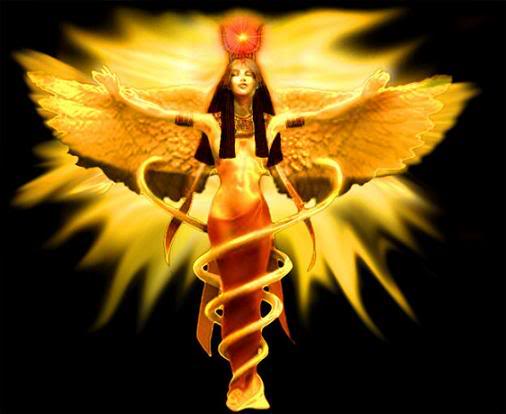

|
|
|
|
|
|
|
|
|
|
|
|
|
|
|
|
|
|
|
|
|
|
|
|
|
|
|
|
|
|
|
|
|
|
|
|
<full text done for the Medicine & 1st Aid Chapter>
SUMMARY
* 1st Aid (d20-1) :
Cures d3 points of damage on a wound, within 1
round of the infliction of that wound.
* Long-Term Care :
1 additional point is healed per day, even if not resting (limit: 1 patient
per healer)
* Treat Poison : +2
on save result (requires start in same round + 5 treat poison actions in
succeeding rounds + poisoned character to wait for 10 rounds)
* Cure Disease (d20-1)
: severity lessened by one step, or, if mild then duration is 1/2 (requires
use within 3 turns of the onset of symptoms, requires 2 curing sessions
per day)
A character with this proficiency can be
a valuable
member of any adventuring party, although
the healing proficiency
is in no way a substitute for a cleric’s
restorative spells.
If a character with healing proficiency
tends to a character’s
wounds immediately (within one round)
after they have been
inflicted, and makes a successful Proficiency
Check, the
wounded character recovers 1d3 HP.
If the character with healing proficiency
tends to a character’s wounds regularly, that
character can recover lost HP at the rate
of one point per
day, even if he does not rest completely.
Under the ministrations of a healer, a
character at complete REST can recover HP at the rate of two per day.
A healer can also attempt to aid a character
who has been poisoned
by venom injected through the skin, such
as from the bite of a poisonous snake
or the strike of an assassin’s envenomed
dagger.
If the healer can aid the stricken character
immediately, the character’s save vs. Poison receives a +2 modifier.
However, the character making the saving
throw must remain at
complete rest for one turn, and the healer
is completely occupied
with ministering to him for five melee
rounds. These time constraints
apply even if the character would have
made the saving
throw normally. If the wounded character
is forced to move or the
healer’s ministrations are somehow interfered
with, the character
must make another (unmodified) save vs.
Poison, and
abide by the results of that check.
WSG: A character
with this proficiency knows how to use
substances found in the wilderness to
aid a wounded or ill character
or creature, and also has some knowledge
of “doctoring”
techniques that can accelerate the healing
of wounds.
If a character with healing proficiency
tends to a wounded character
within one round after a wound has been
inflicted, and
makes a successful Proficiency Check,
his ministrations will
cause the immediate restoration of a maximum
of ld3 hit points
to the victim. No more hit points can
be restored than were lost in
the round preceding the application of
treatment; if a wound
caused only 1 or 2 hit points of damage,
then only 1 or 2 hit points
can be restored regardless of the result
of the die roll.
If a wounded character remains under the
care of someone
with healing proficiency, he can recover
lost hit points at the rate
of 1 point per day even while traveling
or engaging in nonstrenuous
activity. If the wounded character rests
while he is being
cared for, he can recover two hit points
per day instead of the
one point that is normally allowed. This
“continuous care” aspect
of the healing proficiency does not require
a Proficiency
Check, and is assumed to be benefitting
the wounded character
as long as the patient and the healer
remain in the same group.
However, this skill cannot be used on
more than one character
during the same day.
A character with healing proficiency can
attempt to aid a character
or creature who has been poisoned by venom
entering his
body through a wound. If the victim can
be ministered to immediately
(beginning in the same round that the
poisoning occurs),
then his saving throw versus poison is
taken at a +2 bonus. No
Proficiency Check is required to exercise
this ability. However,
the bonus to the saving throw can only
be retained if the victim remains
at complete rest for one turn thereafter,
and if the healing
character continues to aid the victim
for at least 5 rounds following
the round in which the poisoning took
place. If either of
these time requirements is not met, the
victim must make another
saving throw versus poison, with no bonus,
and abide by the result
of that roll. Note that unless someone
in the party has proficiency
in animal handling, it may be fruitless
to try to aid (for
instance) a horse that has been poisoned,
since it is unlikely that
anyone will be able to keep the animal
calm and resting for one
turn.
A character with healing proficiency can
also attempt to help a
character who has been taken ill, either
by a disease occurring
because of the condition of the character
or the environment or
by a disease resulting from parasitic
infestation (see pages 13-14,
DMG, for a discussion of both types
of disease).
If the healing character begins tending
to the victim within
three turns of the onset of symptoms,
and if that character makes
a successful Proficiency Check, then the
severity of the disease
will be one step lower than indicated
by the die roll (terminal becomes
severe, or severe becomes mild). If the
severity of the disease
was already determined to be mild, then
the disease will run
its course in half the time that would
have been required otherwise.
These benefits will only continue to apply
to the diseased
character as long as he receives aid from
the healing character at
least twice per day, at regular intervals,
until the disease runs its
course. If two of these “medicine sessions”
are missed consecutively,
or if a total of three of them are missed
during the duration
of the disease, then the illness reverts
to the level of severity that
was originally indicated.
Note that in order for a character to be
able to exercise his proficiency
in healing, he must possess or have immediate
access to
any necessary materials or substances.
See the section on First Aid and Medicine
for details on the availability of medical equipment
&& medicinal substances.
With certain exceptions,
the rules of the game do not account
for specific injuries or
the effect of wounds on particular parts of
the body. Lost HP are simply
lost HP; in practically
every case when a character
is injured, the exact nature of his injury
is not specified and does
not need to be.
However . . . there are occasions
when logic and circumstances
strongly indicate that an
injured character has a specific
problem. If this is the
case, then prompt action on the part of an
injured character or a comrade
can sometimes reduce the adverse
effect of a wound or other
type of injury.
Some special methods of treatment
are discussed in the description
of the healing
proficiency. These methods include: restoring lost hit
points by promptly tending
to a wound; caring for an injured comrade
to improve his recuperative
powers; and aiding a character
who has been poisoned or
has come down with a disease.
Besides these special skills,
available only to a character with proficiency
in healing, there are some
general first-aid skills that are
common knowledge among most
adventurers and which can be
used by anyone who takes
the time to perform them, assuming
that the necessary materials
are available. Most of these general
skills are only useful if
the DM rules -- with proper
reason, of course - that
a character has suffered a specific type
of injury. Below is a list
(far from exhaustive) of specific injuries
and the proper treatments
that can reduce the effect of the injury
or improve the victim’s
ability to recuperate.
Broken
bone (arm or leg): Putting a splint on the injury will keep
the ends of the broken bone
properly aligned and make healing
possible. A character who
suffers a broken bone in an extremity
will not be able to regain
any HP lost due to the injury until
he is fitted with a splint,
and if he attempts to use the injured extremity
even while it is splinted
he will immediately suffer an extra
1d6 points of damage; in
addition, he will neutralize any healing
of the broken bone that
had taken place up to that time. For purposes
of administering this rule,
assume that for a character with
several injuries, the broken
bone is the last injury for which HP are regained.
Most other types of injuries
(burns, wounds, etc.) will heal before a broken bone is mended.
Minor
burn: The best treatment for a burn is to deprive the affected
area of air by immediately
immersing it in water for at least
two turns or by wrapping
it tightly with a clean cloth. If these measures
are taken, the burn will
heal at the normal rate (1 HP per day).
If the burn is not protected
from the air,
the victim must take a -
1 penalty on all attack rolls and saving throws because of distraction
due to the pain of the injury,
and the burn will heal only
half as fast as normal.
Major
burn: If more than half of a character’s body has been
burned, he must be treated
as described above and in addition
he must be allowed to REST
until he has regained at least half of
the hit points lost due
to the burn. If he moves under his own
power or performs any other
voluntary physical activity before he
is well on the way to recovery,
he will forfeit all the hit points he
had regained up to that
point and will suffer an additional ld4
points of damage for each
round of activity. Also, the victim’s
“pain penalty” is -3 instead
of - 1, applied on all attack rolls and
saving throws. A character
suffering from major burns will usually
still be able to ride a
mount or be carried by a comrade or on a
stretcher, so the party
is not necessarily immobilized during his
recovery period.
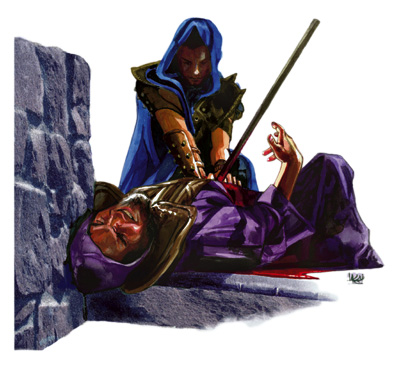
If a character is hit by
an opponent wielding an
edged melee weapon and the
unmodified damage roll is 6 or
higher, the DM may rule
(at his discretion, or on a
25% chance) that the weapon
blow struck an artery, causing severe
bleeding.
A character who suffers this type of major wound
will lose an additional
2-4 (1d3 + 1) HP per round thereafter
until the wound is tended
to. Either a comrade or the victim himself
(if the wound is in an accessible
place) can stem the bleeding
by applying pressure directly
to the wound for 2-7 consecutive
rounds (1d6+1). While the
pressure is being applied, the victim
will lose 1 HP
per round until the required amount of time
has passed (at which point
the bleeding has been stopped). Although
the bleeding can be halted
by wrapping the wound tightly,
the victim will not be able
to recover HP lost from this injury
unless this procedure is
performed by a character with proficiency
in healing. If the pressure
is released before the necessary
time has gone by, the benefit
of the first aid is negated;
bleeding will begin again,
and pressure must be applied for another
2-7 rounds (the DM can either
use the original
result, or roll again for
an added amount of randomness) before
the bleeding is stopped.
Minor
wound: It is assumed that any character who suffers a
wound that breaks the skin
will at least BANDAGE the wound, or
have it bandaged by a comrade,
at the first available opportunity.
Any wound that does not
cause severe bleeding (see above) will
not get worse, in terms
of lost HP, if it is not tended to. However,
a character who totally
disregards his injuries by not even
bothering to have them covered
should be penalized by having a
greater chance of contracting
a disease due to infection. Perhaps
he won’t get sick -- but
if he does, he and his comrades will soon
learn to appreciate the
good sense of caring for injuries when
they occur.
Skin
ailments: This category of injury includes rashes and insect
bites. Neither type of injury
is important, and neither one
should be dealt with in
game
terms, unless the DM
rules that the ailment has
a noticeable effect on the victim. The
itching or pain that results
from such an ailment may impair a
character’s ability to perform
a delicate task, such as a thief attempting
to disarm a trap or a spell-caster
concentrating during
the casting of a spell.
The DM should attach a penalty
to the chance of success
that is appropriate for the situation.
For instance, a thief’s
chance to remove a trap should be reduced
by one-quarter or one-third
of the usual percentage, depending
on the severity of the affliction;
the chance of a spell
being ruined during casting
should be set at from 2% to 10% for
each segment of the spell’s
casting time. A magic-user casting
feather fall (casting time
1/10 segment) will be able to get the spell
off even if he is itching
like crazy, but he is better off not trying to
cast find familiar (casting
time at least 1 hour) until the itching or
pain has subsided. A minor
skin disorder will clear up by itself in
1d3 days if it is not aggravated,
and the healing time can be reduced
by the application of an
appropriate medicinal plant such
as chaulmoogra oil or plantain
(see DMG, Appendix J).
Other types of injuries -
sprains, concussions, internal injuries,
pulled muscles, torn ligaments,
and so forth -- are not considered
here for 2 primary reasons.
* 1st, adventurers (who are
generally presumed to be
in good shape and possessed of good
sense) do not suffer these
sorts of injuries very often, and so any
rules concerning their likelihood
and their treatment would probably
have little usefulness.
** 2nd, there is a tremendous
amount of variability in
the intensity of these sorts of injuries and
their effect on the victim.
If it is important to the participants in a
campaign to have rules on
how to handle a minor sprain versus a
severe sprain or a pulled
leg muscle versus a pulled shoulder
muscle, it should be a fairly
simple matter for the DM
to develop rules for how
such injuries affect a character and
how the injury is best treated
to enable the victim to heal as
quickly as possible.
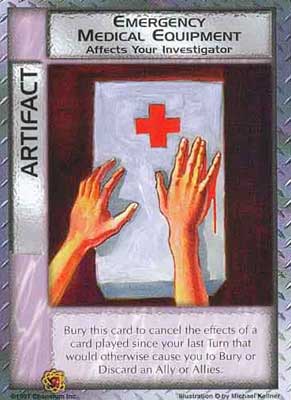
Unless characters expect
to go through an adventure unscathed
(and what adventurer in his right mind
expects that?), it
is a good idea for the party to include
in its gear some of the necessary
materials for administering aid to those
who are injured in the
line of duty. Brief descriptions of some
of the esssentials are
given below.
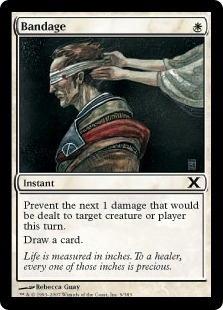
At least one person's backpack should contain
several
swatches of {clean}
fabric for covering and binding wounds
and burns. In a pinch, some article of
clothing can be torn into
strips and used as bandages, but an adventurer's
clothing
is
usu. not clean (so that there is a possibility
of infection even if
the wound is bandaged) -- and what will
you wear after you USE
the shirt off your back to cover and protect
your wounds?
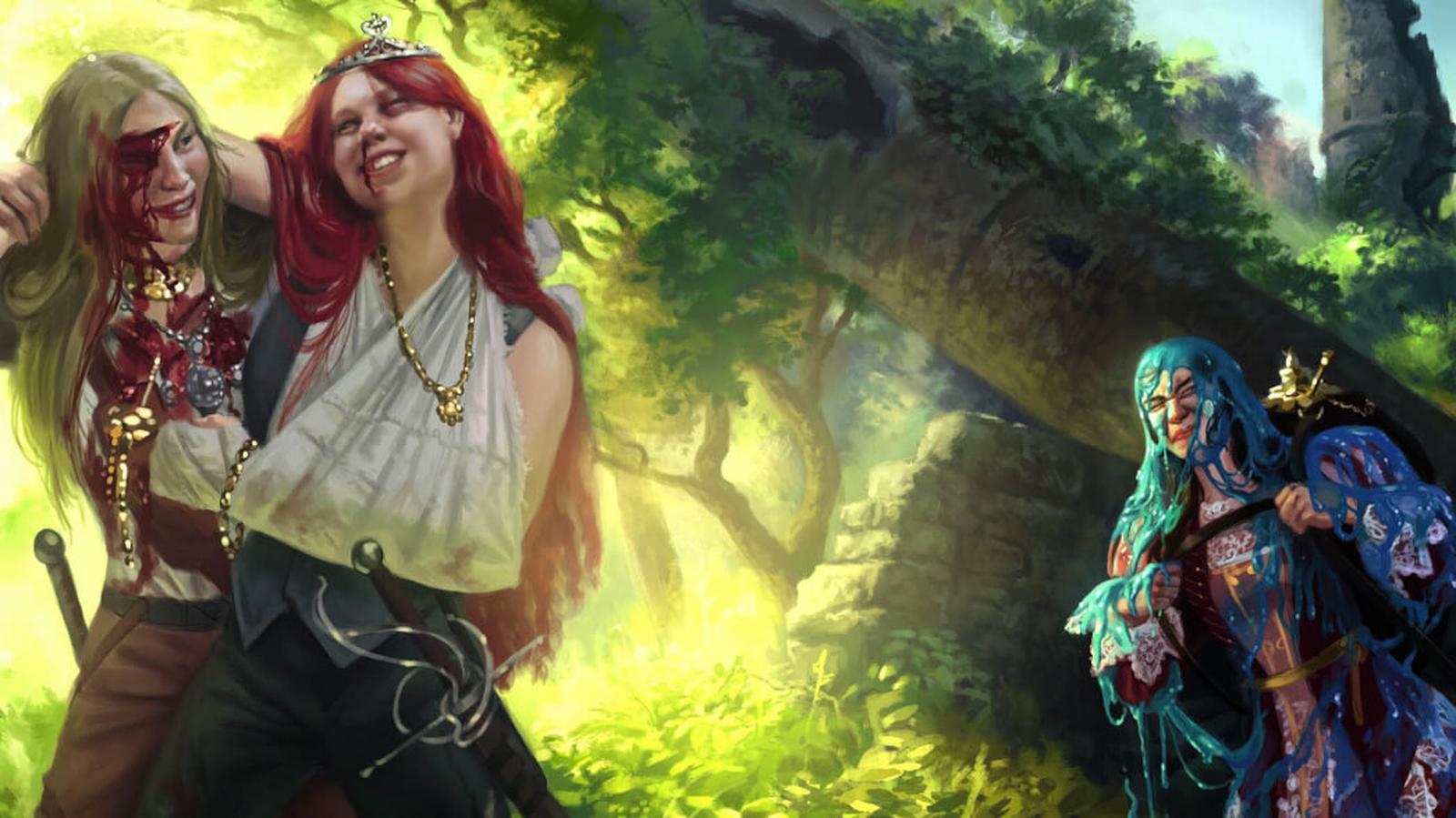
Splints: If
characters know they are going to be traveling
through a wooded AREA during at least
part of their journey
through the wilderness, it may not be
necessary to set out with
splints among their gear. But if they
have to climb a mountain or
cross a desert, it is wise to pack at
least a couple of straight, short
(2-3 feet long) pieces of wood or some
other rigid material that
can be bound along the sides of a broken
limb to keep the bones
properly aligned. A large piece of thick
leather or untanned hide
(perhaps acquired along the way) can be
used as a splint, as long
as it is large enough and rigid enough
to keep the limb and the
joints on both sides of the limb immobilized,
in the same manner
that a plaster CAST is used in present-day
medicine.
Stretcher:
Although a stretcher can be fashioned from its component
parts before it is needed and then transported
as part of a
party’s gear, most groups of adventurers
will prefer to carry the
parts separately and assemble a stretcher
if and when it is
needed. The necessary parts are a pair
of poles at least as long
as the injured character’s height, one
or more pieces of sturdy
cloth || leather large enough to offer
a surface upon which the
victim can recline, and some means (rope
|| cord of sufficient
length) of binding the poles to the edges
of the cloth or leather.
Two comrades can carry an injured character
on a stretcher, as
long as each of them is able to support
half of the victim’s weight
without being too encumbered to move.
Litter: This
piece of equipment is essentially the same as a
stretcher, except that extra rope
|| cord is required to bind the
victim to the frame. One character (or
one mount or beast of burden)
can transport a character who is bound
into a litter, as long
as the carrier is able to support half
of the victim’s weight without
being too encumbered to move. It is usually
not wise to try to
transport a character in a litter over
rugged
|| very rugged terrain, <e>
because one end of the litter is always
on the ground and the injured character
can be jostled as the litter skids and
bumps along the ground. If it
is important for the victim to be kept
more or less motionless because
of the nature of his injuries, the DM
may
decide
that a trip over rugged or very rugged
terrain will actually
cause the character to suffer further
damage as a result of the
rough handling.